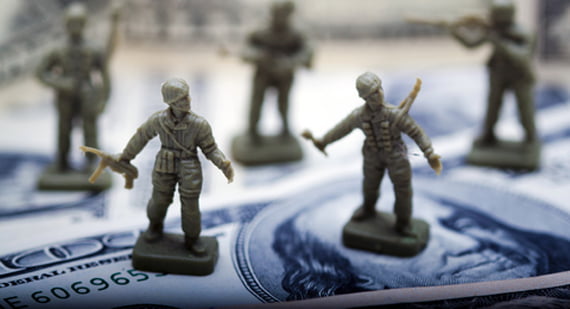Let us fend off disinflation
Inflation is a vital component of economic strategy, used by the Federal Reserve (the Fed) to steer the economy and combat unemployment. The Fed’s inflationary goals are set at around 2% per year.
During recessions inflation decelerates, a phenomenon called disinflation. Disinflation is a precursor to and warning sign of potential consumer deflation.
When decelerating, inflation does not simply stop at zero. When it drops to less than zero, disinflation turns into consumer deflation. Consumer deflation manifests itself as a drop in prices for goods and services, a reduction in money supply, a drop in spending and reduced employment. Consumer deflation is catastrophic, and can lead to economic depression.
Both the Fed and Congress have tools to stop and reverse disinflation before it reaches the deflationary threshold. The Fed does this by wielding monetary policy; Congress does this by wielding fiscal policy (i.e., spending). Inflation is often reported as static, but in fact it’s a constantly moving figure affected by multiple economic factors. Thus, the Fed constantly adjusts its monetary policy based on the behavior of consumers and businesses.
Editor’s note —The Fed’s use of monetary policy is like steering a car: small corrections are required to react to changes in the road.
To begin an inflation-deflation analysis, we review the Fed’s three primary responsibilities. These responsibilities are to:
- distribute money into circulation for use as the population’s medium of exchange;
- keep the labor market stable; and
- maintain inflation at a proper level (2-3% is the time-honored inflation target).
In conventional monetary policy, the Fed controls the rate of inflation by:
- lowering interest rates to increase inflation; or
- raising interest rates to decrease inflation.
However, the Fed was unable to engineer a recovery after the 2008 recession and financial crisis by simply adjusting interest rates.
The problem: low inflation concurrent with zero lower-bound interest rates.
Inflation and interest rates won’t rise to healthy levels until consumer spending increases. Consumer spending has been weak for several reasons, including:
- lack of jobs;
- austere government budgets;
- lenders hoarding reserves;
- an abnormally low “real” interest rate (the low inflation and zero lower-bound interest rate issue); and
- the Fed’s lack of political will to go negative on rates for lending and reserves.
As a supplement to Fed monetary policy, the government can also step up spending, shouldering the burden of job creation until consumer confidence and consumer spending normalize. This type of government spending is called stimulus. Stimulus creates jobs (and thus spending) in two ways:
- indirectly, by providing money to the private sector to encourage hiring; and
- directly, as the employer of last resort when private consumption is so low that private employers will not add staff.
Related article:
Lenders given a risk-free run
Since 2008, short-term interest rates have been essentially zero. They will likely stay at zero until 2016. Together with low inflation, this produces the zero lower-bound interest rate dilemma. By refusing to “go negative” on lending or reserve rates, the Fed diminishes the effect and variety of its monetary policy weapons in the fight to attain its employment and inflation goals.
However, as an unconventional monetary policy move, the Fed has been pumping cash into the economy by buying up bonds. This is how it works: the Fed creates money, then uses it to purchase bonds sold by the banks. These funds sit in lender vaults as deposits. Ideally, the banks then use these deposits to make loans and stimulate consumer spending.
Editor’s note — There is a concern that the Fed’s expanding balance sheet will cause hyperinflation by adding more money into the market and rapidly devaluing the dollar. However, the Fed is able to control inflation by raising the interest rates it sets on bank reserves.
Specifically, in September 2012 the Fed began purchasing billions of dollars of 30-year Treasury bonds (T-bonds). This mass purchase was part of the third round of quantitative easing, dubbed QE3. This round of large-scale asset purchases injected fresh cash into the money supply to create a degree of borrowing, spending and inflation. QE3 was preceded by similar stimuli in the form of QE2 (November 2010) and QE1 (November 2008).
When purchasing long-term T-bonds at higher prices than private banks are willing to pay, the Fed effectively continues lending to banks at virtually 0% interest rate. This action simultaneously and indirectly lowers interest rates for consumers since reduced earnings on bonds forces lenders to lend to consumers.
This is where mortgage lending enters the scene, but lenders have spoiled the game by refusing to lend.
Private lenders behave in much the same fashion as consumers. When times get tough, they hoard funds (reserves) and only engage in the lowest-risk ventures. They lend to the government to fund its stimulus spending, and hold zero-cost Fed funds on deposit in their cash reserves. This investment arrangement eliminates virtually all risk while creating a healthy annual return for private banks. However, this creates difficulty for homebuyers seeking to take out loans.
Without some other impetus, lenders have no motivation to lend money to higher-risk borrowers in the consumer, real estate or business markets. Lenders exploit the government’s mandate to keep the money supply open to the public. They reap all the rewards of their relationships with government agencies, but are slow to do their part by delivering loans to consumers.
Lenders await qualified buyers
QE3’s planned effect on the U.S. economy is to encourage private borrowing, investing and hiring.
Under QE3, the Fed has pledged to pump money into the economy until it is sufficiently stimulated into a period of real and positive growth. In finite terms, the Fed’s QE3 goals will be met once the national unemployment rate drops to 6.5%. As of October 2013, the U.S. unemployment rate was 7% (the lowest since 2008).
Related article:
Of course, Congress can offer meaningful fiscal policy to shorten the time it takes to hit the Fed’s unemployment rate target. As keeper of the government purse strings, Congress can quickly produce demand by aggressive spending. But Congress is in austerity mode for 2014, unwilling to spend to get people back to work and businesses back to investing in plant, equipment and labor. Thus, the Fed toils alone.
The Fed’s purchase of notes, bills and bonds injects cash into the market at reduced interest rates. During times of high inflation, this prevents deflation and lifts employment. And again, recall that deflation is far more catastrophic than the more easily controlled inflation.
As employment increases, consumers will regain their confidence to qualify for loans to purchase real estate.
The deflationary warpath
The Fed’s monetary policy response to fight deflation has a significant impact on the U.S. housing market. For illustration, let’s look at two examples of how housing was impacted by government responses to adverse economic conditions.
Both Chile and Japan suffered financial crises during the early 1990s.
Chile quickly seized and liquidated their insolvent banks. They then promptly sold off the remnants. This flushed out the bad loans, allowing Chile to recover quickly after a brief but abrasive period of economic distress. It was effective medicine, as Chile’s economy has grown significantly ever since.
Not so for stoic Japan. In contrast to Chile, Japan held interest rates low following their 1990 financial crisis. They did this not to encourage growth, but to prop up their larger insolvent banks. Japan reasoned that by keeping money cheap, the banks’ profits over time would bring them solvency. None of the large Japanese banks were seized.
As a direct result, Japan experienced a 20-year economic depression. Japan’s economic depression did not abate until 2013, when its central bank injected massive amounts of cash into the economy. Japan broke its 20-year policy stalemate only after its central bank witnessed the success of our Fed’s massive QE programs as a means of avoiding deflation.
Still, the damage was done: today, real estate prices in Japan are half of what they were before their financial crisis.
The recession is over, and the U.S. is in recovery. However, our monetary and fiscal policies need improvement if we’re to hit a steady recovery pace and avoid a decades-long economic malaise reminiscent of Japan’s deflationary period.
Economists are concerned that the increasing power of cash and near-zero interest rates means we are heading towards consumer deflation. Consumer inflation in 2013 was at 1.2%, and it is declining going into 2014. Seven years after the onset of our financial crisis, it’s a dangerous state of affairs.
Deflation is being kept at bay through the Fed’s efforts to avoid the Japanese experience — but recovery through monetary policy alone is slow going. Without help from Congress to create jobs, the Chilean-type recovery eludes the U.S. economy and housing market.














Dear John,
If you purchased any first tuesday courses during the past year, one year of journal access is included as part of your enrollment. To access full journal articles, simply log in with your BRE license number (ex: 00123456) and your last name.
If your courses are more than one year old, you may purchase an Annual Membership, which comes with access to the first tuesday journal online, forms and FARM letters, the Realtipedia and more.
Thank you,
first tuesday Editorial Staff
Hi: I bought my education classes this year through First Tuesday. Not sure why this publication was not covered as promised. John C. Gilbert, Bakersfield, CA.